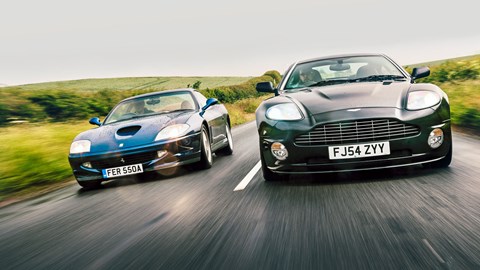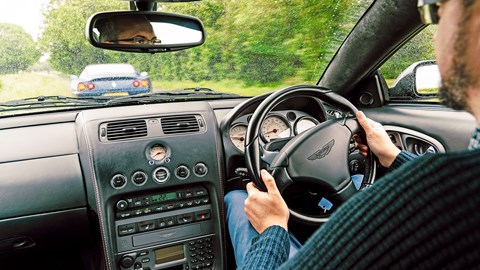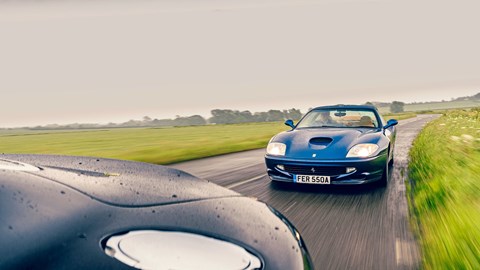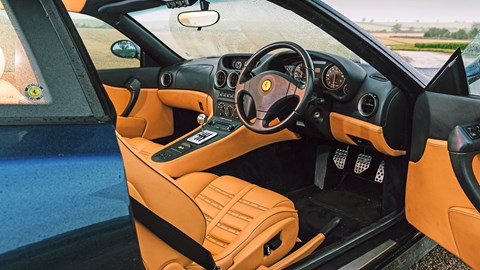► Ferrari 550 vs Aston Martin Vanquish
► Two classic V12 GTs
► Which would you pick?
Class. It’s one of those intangible virtues you either possess or you don’t. It’s not about money – Donald Trump proves as much – it’s about style and grace. It’s tough to think of any GT manufacturer that exemplifies these characteristics as much as Aston Martin.
Ever since the firm moved to Newport Pagnell in the 1950s, the overriding culture at Aston Martin has been one of creating wholly elegant machines. It started with the DB4 and ended with the V12 Vanquish.
From 1955 to 2007 just 13,300 cars were made at Aston Martin Works, each and every one crafted by hand, rather than simply assembled. A mass production mentality didn’t exist at Pagnell. I saw this first-hand when I was given a tour before the factory wound down 49 years of production on July 19, 2007. The sensation of hearing one of the final 50 Vanquish S Ultimate Editions firing-up for the first time and driving out of the gates was something I’ll never forget.

Twelve years later – one for every cylinder in that Aston – I’m back at Newport Pagnell, standing in the rain and taking in the glory of another black Vanquish S, trying to ignore Nathan’s protestations that the Ferrari 550 Maranello is the finer choice. More on that later… The current site still services Astons and builds some rather pricey continuation specials, but that’s it. In the decade and a bit since my last visit, the motoring landscape has changed about as much as the Pagnell site.
The final nails in the production V12 engine’s coffin are being hammered down as even Mercedes-Benz has bid farewell to 12-cylinders. Tradition counts for little in the face of a car industry obsessed with ‘eco perception’. In a similar fashion the old sheds that formed the factory at Newport Pagnell have been replaced by a brand-new multi-million pound showroom. Its acres of glass and acute angles are all very clean and ‘on trend’, but many of the craftsmen building world-beating sports cars have long gone. Times change, of course, and set against the current brutal modernism pervading car design the Vanquish looks classically understated.
It’s fitting that this model saw out production at Pagnell – it’s the perfect balance of old-school brawn mated to a new (for the time) design ethos. Ian Callum’s flowing lines gave the Vanquish both latent aggression and striking beauty. There are nods to tradition with that full-width grille, fared-in headlights and wing vents separated by chrome slashes. It all gets a little bulbous around the rear, but overall it has aged gracefully and clearly paved the way for most Astons that followed.

Open the door and you’re greeted by an interior that’s something of a mixed bag. There are splashes of quality – the Alcantara A-post covers and the diamond stitched headlining, for example – but elsewhere the Vanquish suffers from the same parts-bin pillaging as the DB7 before it. The centre console and inner door pulls will be very familiar to Jaguar XK8 owners, but does it matter? When there’s 520bhp of naturally aspirated V12 under your right foot will you really be thinking about the quality of the electric window switches? Well, let’s find out.
Aston Martin Vanquish: what to look for
- The engine is robust, but it’s the semiauto ‘box that has most of the problems. It doesn’t like creeping in traffic as this wears the clutch. Around 90 cars have had a manual conversion.
- Ignition coils can fail and, due to labour costs, it’s worth doing the whole bank at a cost of £1000.
- Corrosion in the subframe has been reported. A new one is £5k plus 16 hours of labour. Sill brackets are made from mild steel and the sill itself is alloy leading to electrolytic corrosion.
- Blocked air-conditioning drains can lead to moist carpets. Check very carefully for bubbling under the paintwork after stonechip damage as the aluminium body can be tricky to put right.
- Standard oil (0-W30) is thought to be too thin. Try 0-W40 instead.
- What to pay: Concours £160,000 Good £120,000 Usable £70,000 Project Unlikely
I can’t just jump in and go in a Vanquish. There’s a checklist to complete before I can have some fun. I first have to place the Tremec T56 six-speed gearbox into neutral by pulling both transmission paddles at the same time. This results in a big confirmatory ‘N’ appearing on the dash. I can then push and hold the start button at the top of the centre console. After a few manic cycles of the starter the V12 bursts into life with a howl.
It’s a spinetingling sound that’s full of exotic supercar overtones. Theatrical and perhaps a little out of character for a big GT, but then again it certainly draws admiration from the locals. Camera phones swing in my direction and I’m suddenly self-conscious as I try to edge this big GT onto the busy road right outside Works Service.
The semi-automatic transmission isn’t helping. It’s an electrohydraulic manual which basically means I select the gear with a paddle and the clutch is hydraulically operated for me. It’s not without its foibles on the move – we’ll get to that shortly – but its flaws are most evident at parking speed. The problem is the need to come to a complete standstill before hitting the ‘R’ button on the centre console to back up. Without a conventional clutch there’s also no biting point, meaning my first few attempts are a little jerky. No doubt it’ll be uploaded onto social media by the time you read this.

Free of narrow and congested street traffic, I’m at last able to sample the delights of the Vanquish. The roads are sodden and it’s frankly awful outside, but in here I’m perfectly ensconced in sensory-deprived opulence. The slippery 0.32cd Vanquish S doesn’t make much in the way of wind noise to begin with, but there’s also so much material between me and the outside world that the drone of the tyres and the howling weather are reduced to a whisper. The peace doesn’t last too long, though, as there’s a straight ahead.
Putting the Vanquish in ‘Sport’, I pull the left paddle and feed in some power. The peaceful serenity is shattered in an instant as a ratio drops, the exhaust bypass valves open and a V12 scream fills the cabin. The S gets to 60mph in 4.7 seconds and will keep going all the way to 199mph. In this weather I’m only able to deploy its 520bhp firepower in short, controlled bursts, but even with considered use of the right pedal this thing still slithers about trying to get all those rampant horses through the 285 cross-section rear tyres.
To get the best out of the semiauto, I need to lift off the throttle for every change, as with a conventional manual. Using this technique, the ‘box becomes perfectly useable, albeit not as sophisticated as a modern full-auto or as satisfying as an old-school manual.
Nevertheless, it’s easily less arduous than an open-gated Ferrari manual. Let off the lead, this Vanquish is devastatingly fast, seeming to batter the laws of physics into submission. It weighs as much as a Range Rover Classic but accelerates faster than an original Lotus Elise. Inevitably, though, its weight does make itself evident. Braking for a tight corner shifts the bulk onto the nose as the heavy steering becomes even more so.
Despite the V12 being placed way back near the bulkhead, it’s a large lump and, at the limit of adhesion, it’s the front that gives up first. Mild hints of understeer creep in but are easily overcome with some throttle. This isn’t the best day for exploring chassis dynamics anyway and I quickly back off, remembering that GTs aren’t really about ultimate handling. With the transmission set to ‘ASM’ mode, I allow it to pick its own shift points. I still need to back off the throttle for the changes to avoid uncomfortable lunges in between gears. This proves a little tricky as I need to guess when the ‘box will decide to shift up.
A few miles later, I adjust and once more the Vanquish does a creditable impression of a Noughties man-cave on wheels. The number of toys in here is certainly on a par – the only things missing are a PS2 and a copy of GQ. I’ve got a 13-speaker premium Linn audio system, Bridge of Weir leather-clad electric and heated seats that are perfectly sculpted and cushioned, plus rear parking sensors, air-conditioning and all the refinements you’d expect of a car that cost £177,100 new.
Handcrafted cars like the Vanquish aren’t long for this world. The era that spawned it was free from concessions. Driver engagement wasn’t sacrificed in favour of smartphone integration or lane-departure nannies. It’s a thoroughbred in the old-school mould. As such, it has its foibles and you need a degree of patience to extract the best from it but get it right and it’s simply glorious.

And now, the Ferrari
JJ’s got it all wrong. Power, passion, pedigree – here’s something from the Prancing Horse that can easily dismiss the Aston with a canter. Say hello to the magnificent Ferrari 550 Maranello.
You only need to cast your eye over the Pininfarina-penned lines to see the breeding; the long bonnet and short rear profile screams Daytona, while the gills behind the front wheels hint at the 275 GTB. Step inside and there are Daytona-style seat inserts and an open-gated manual gearbox. Under that engorged bonnet lies a naturally aspirated V12 – two words and a sequence of letters and numbers as steeped in Ferrari lore as any heralded Formula One success.
From the moment this particular little yellow badge poked its way into the public consciousness it courted controversy. For the previous 23 years, the flagship Ferraris had been either flat-12s or turbocharged V8s. Sticking a big V12 up front could have been seen as a retrograde step, making the 550 a pastiche of the glory years of front-engined Ferraris in an era of retro design. A VW New Beetle for plutocrats, then? No – dig a little deeper and it becomes clear that this was a big Ferrari like none that had gone before.
Even more than the F355, it shows the persuasive, pragmatic hand of Luca Di Montezemelo, the modernising force behind Maranello’s 1990s renaissance. At launch, it was called ‘the boss’s car’, and he spoke of hating how Ferrari owners never really drove their cars. ‘The front engine has a lot of advantages: room, luggage space, the possibility to enjoy the car much more than a car in which you cannot move or talk,’ he said.

This was a Ferrari for every day. It doesn’t take long for that ethos to become apparent – even my 6ft 5in frame has no trouble getting comfortable in the airy cabin. All the elements are clear, with none of the ergonomic peculiarities you’d usually associate with exotic Italian machinery. Only the argumentative fly-off handbrake comes close to forming a frown. Instead it’s more satisfying to focus on the abundant glass, slim A-pillars and unobstructed view out of the back.
Twist the key and the 5.5-litre Type F133 fires up with a deep induction roar and a distinctly mechanical clatter. It certainly lacks the tuneful baritone of the Vanquish, sounding a bit like a 1980s Mercedes-Benz V8. Heresy? Perhaps. But this wasn’t designed to be a car for extroverts
Di Montezemelo was hardly unforthcoming in expressing his dislike for the Testarossa/512’s bombastic nature. If you think the most satisfying part of owning a Ferrari is telling people that you own a Ferrari, the 550 is not for you. Reducing mechanical and exhaust noise was a key part of the project, with the use of hydraulic tappets and open-end Helmholtz resonator pipes in the intake to remove excess boominess. It’s a Ferrari for adults. And, initially, it works.
The steering is well-assisted at low speed, though the turning circle is hardly easy. As the speeds increase, the steering firms up, never less than incisive. It’s more communicative than, say, the 612 Scaglietti I drove earlier this year, but then we come to the gearbox.

Ferrari 550 Maranello: what to look for
- If an early car is unwilling to select first, third and fifth, you’re looking at a gearbox rebuild – make sure it doesn’t jump out of gear under load.
- Clutches last for 10k miles or 20k miles depending on your driving style.
- Cam seals can wear and leak, so are best replaced at the same time as the cambelt.
- Split or worn hoses can cause water leaks into the engine’s V. Silicone hoses can stop this happening, but it’s worth changing hoses every four years.
- Pooling water from blocked drain holes at the windscreen’s base can cause leakage on to the ECU.
- Every 30,000 miles you might experience play in the steering wheel – a rack rebuild isn’t too horrific but the bushes and hub bearings mount up.
- Aluminium bonnet and bootlid lip can corrode. Wheelarch rust also common.
- What to pay: Concours £130,000 Good £100,000 Usable £90,000 Project Unlikely
The open-gated Ferrari manual shift is the stuff of legend: beautiful to look at and heart-soaring to listen to. Even manipulating the canted-over lever at rest brings to mind age-old GT driving tales from the likes of Paul Frere, ruminating on NVH issues at 170mph. The mere presence of an open-gated manual should surely be enough to make me weak at the knees, bring a tear to the eye and induce sogginess at the keyboard rather than cold-hearted rationalism.
Marshalling 485bhp and 420lb-ft requires a gearbox of immense strength, and the 550’s is certainly beefy. The traditional Ferrari reluctance when getting into second aside, it’s a proper work out, much like other ’90s GT gearboxes, and bordering on obstinate. I love this physicality – it’s a blessed relief from more modern cars and their blancmange-style gear-shifts – and it’s easy to dismiss any criticism with ‘well, it’s designed for high-speed blasts’. That may be true, but at either end of those blasts there are such irritations as cities, hotel car parks and ski resorts.
The 550’s shift isn’t positive and it’s oddly spaced – quick-shifting into third is a particular lowlight. It’s easy to see why Aston Martin decided to drop a manual ‘oar’ for paddles in the Vanquish – if it all goes wrong in the Ferrari, quick shortshifting would be a challenge unless you’ve been mainlining spinach. It’s telling that when the 575M rocked up with an F1 gearbox, the majority of owners ditched the manual. It’s just easier.
Right now, I don’t particularly care about life being easier. The sheer physicality of the shift helps to define this car, perhaps more than the engine. Again, it seems like heresy to say that, but even when you extend it to 7000rpm, where it unleashes all of its horses, it doesn’t have the characteristic scream of later V12s. It still sounds great – a serrated shriek as you light up the higher end of the rev range – but it’s more muted than you’d expect.
But this is a Ferrari and the chance to take in some more challenging corners reveals the 550’s trump card over the Vanquish. Despite tipping the scales at 1690kg, there’s a fluidity to hustling it along a B-road that’s scarcely believable. Mounting the gearbox at the rear means perfect 50/50 weight distribution, and you feel the car pivot round you, the bulk seemingly shrinking away.

Turn-in is sharp, aided by a high-geared rack that’s 2.2 turns from lock-to-lock. Steering feel is direct, the information granular, the gearbox gripes seemingly far behind. There’s enough torque to not bother with second even on tight corners, and suddenly it makes sense.
The dampers at each corner are electronically controlled independently. Stiffening the outside damper and softening the inner allows for greater comfort and grip. There’s more body roll, and pitch and dive, than you might experience in a newer Ferrari, but then they won’t ride quite as well. It’s a little firmer than the Aston, but you only notice over fine corrugations.
Head back to the motorway and there’s simply so much torque that dropping down to fifth to blast past dawdlers seems pointless. Pointless – but fun and deeply addictive. Like all big manual European GTs from the 1990s, the 550 initially feels like a dinosaur: too wide, too heavy, too unwieldy. But the more time you spend with it, the more you warm to its ways and begin to forgive it. No – you begin to love it.
Even the gear-shift? Let’s just say my keyboard is now as soggy as our photoshoot.

The Modern Classics view
For some, this might be an odd pairing – after all, the Vanquish was launched five years after the 550. But without Ferrari’s revolutionary mixture of passion and pragmatism, the Vanquish might not have been the car it is. Without the 550 as inspiration, would Aston have taken the leap on from the brutal but brutish Aston V8 Vantage?
The Ferrari, for all its modern touches, still represents the last of a certain era of GTs. By 1996 it was already an anachronism – the big manual European GT car was dying. However, this is what makes it such a fascinating modern classic – it’s modern enough to take on Europe’s autoroutes without a sweat, but you still get to live those old-school Ferrari dreams thanks to the unmistakable clack-clack of the open-gated shift, and the unstoppable urge from the V12.
The Aston builds on this and passes on the baton – it’s even more useable and, surprisingly, more extrovert. On longer journeys, it’s the one that’s more cosseting, more refined and much easier to deal with once you’ve mastered the semi-automatic gearbox. Nathan and I will never agree on this – he’s more of an adrenaline junkie than I am and is more willing to forgive the 550’s foibles for its pure excitement. For me, the Vanquish wins, despite the gearbox. It’s simply the more complete GT car in the purest sense.
| SPECIFICATIONS |
FERRARI 550M |
ASTON VANQUISH S |
| Engine |
5474cc, 12-cyl, DOHC |
5935cc, 12-cyl, DOHC |
| Transmission |
RWD, 6-speed manual |
RWD, 6-speed semi-auto |
| Power |
485bhp@7000rpm |
520bhp@7000rpm |
| Torque |
419lb-ft@5000rpm |
426lb-ft@5800rpm |
| Weight |
1690kg |
1875kg |
| PERFORMANCE |
|
|
| 0-60mph |
4.6sec |
4.7sec |
| Top speed |
199mph |
199mph |
| Economy |
20mpg |
18mpg |